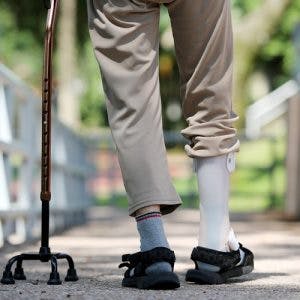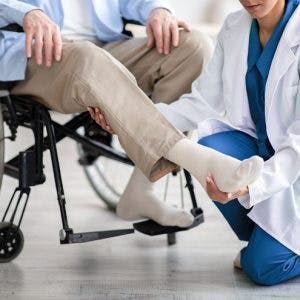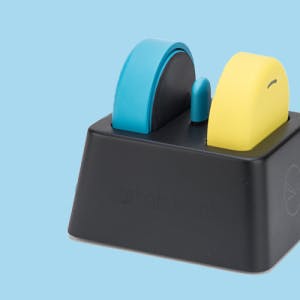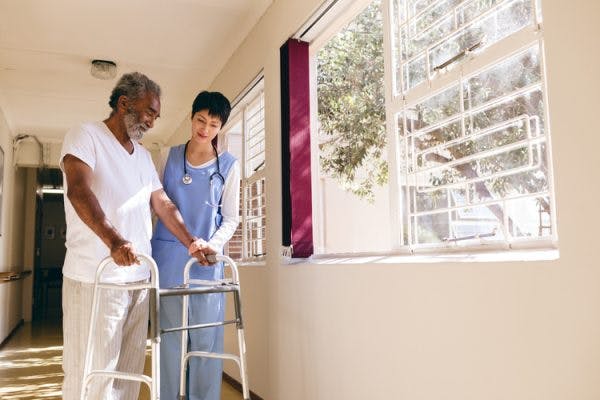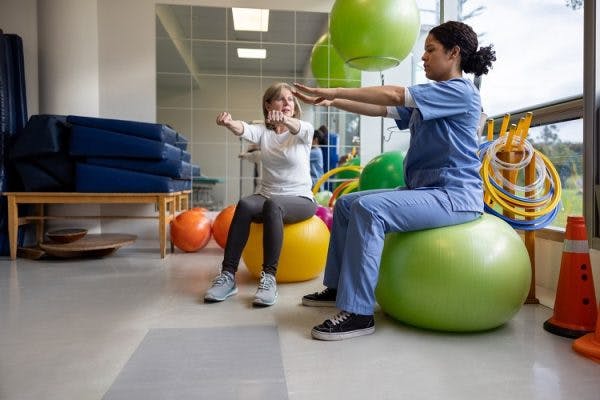Aphasia is a communication disorder that involves a loss of ability to understand or express speech after neurological injury. There are many types of aphasia, each with its own unique symptoms. Conduction aphasia, in particular, refers to the inability to repeat words or phrases.
The good news with conduction aphasia is that, in most cases, other areas of language are only mildly impaired. To help you understand the causes and recovery process for conduction aphasia, this article will discuss:
- Causes of Conduction Aphasia
- Characteristics of Conduction Aphasia
- Diagnosing Conduction Aphasia
- Treatment for Conduction Aphasia
- Is Conduction Aphasia Permanent?
- Understanding Conduction Aphasia
Causes of Conduction Aphasia
Conduction aphasia is traditionally understood to be caused by damage to a particular area of the brain, like after a stroke or brain injury.
In this case, damage to the area of the brain related to conduction aphasia is usually damage to the arcuate fasciculus, a white matter tract that runs between Broca’s and Wernicke’s area. These are the two main language centers of the brain.
Broca’s area is responsible for producing speech, while Wernicke’s area is responsible for understanding speech spoken by others.
Damage to the arcuate fasciculus limits communication between those two areas. This may explain why it causes a person to have difficulty repeating phrases.
When conduction aphasia occurs, the parts of the brain responsible for processing language (Wernicke’s area) have become separated from the parts responsible for producing language (Broca’s area).
These two main language centers of the brain usually reside in the left hemisphere. As a result, aphasia is more common after a left hemisphere stroke or left hemisphere brain injury.
Characteristics of Conduction Aphasia
A person with conduction aphasia will struggle to repeat words or phrases, but can still read, write and speak fluently. Although they cannot repeat what others say, they can still understand them.
Therefore, if you ask a person with conduction aphasia to write down what you said, they can — however, they cannot repeat it verbally.
Some people with mild conduction aphasia can still repeat short words and phrases but struggle with longer and more complex sentences. Patients with severe conduction aphasia might be unable to repeat single words.
Another characteristic of conduction aphasia is repeated attempts at self-correction. Because the person with conduction aphasia is aware of their errors, they will try to correct themselves. For example, if asked to say “refrigerator,” the patient might say “Frigilator…no, frerigilator,” until they may eventually say the word correctly.
Finally, some individuals with this type of aphasia can also struggle with word-finding skills (a problem associated with anomic aphasia). However, this combination is rare.
Diagnosing Conduction Aphasia
Several standardized tests exist for diagnosing and classifying the various types of aphasia. For example, the Boston Diagnostic Aphasia Examination (BDAE) and the Western Aphasia Battery (WAB) are two commonly used tests to diagnose conduction aphasia.
These examinations include a series of assessments, which require a person to name pictures, read printed words, count aloud, repeat words, and identify images. In addition, neuro-imaging such as MRIs or CT scans are effective in diagnosing strokes, tumors, infections, or other conditions that may be the cause of your aphasia.
Once your doctor has determined that you may have conduction aphasia, you can begin seeking treatment.
Treatment for Conduction Aphasia
The primary treatment for conduction aphasia is speech therapy. Specifically, speech therapists use sentence repetition therapy, in which each week, the patient must practice a set of sentences every day. At the end of the treatment, the patient often improves their ability to repeat words and phrases.
This therapy often proves effective because the repetition of an activity stimulates neuroplasticity. Neuroplasticity refers to the brain’s ability to form new neural pathways in response to changes in environment or stimulation. These pathways allow healthy portions of the brain to perform functions previously controlled by injured ones.
Patients can increase neuroplasticity through intensive repetition. Therefore, by encouraging a patient to practice repeating sentences, therapists can help the person rewire their brain and recover some function.
This is one reason speech therapy apps at home are so effective. There’s no reason to limit your therapy to when you are in person with the therapist. Your brain needs many more inputs to rewire itself. For improvement, you will need to continue therapy between visits at home. This is not so easy for most. That’s why expert speech-language pathologists created the scientifically-based CT Speech & Cognitive Therapy App to encourage patients to keep up their exercises at home.
It works best to use speech therapy apps in conjunction with attending speech therapy.
In addition to these exercises, a speech therapist can also teach aphasia patients certain compensatory tactics. These are strategies that replace what the lost skill accomplished. For conduction aphasia, simply writing what others say down and using text-to-speech devices can help make living with this type of aphasia a little easier.
Is Conduction Aphasia Permanent?
Symptoms of conduction aphasia are mostly transient, lasting anywhere from a few hours or days. This is especially the case when it occurs after a mild stroke or concussion. As the brain heals, impairment will typically decrease, and the aphasia should fade.
However, in more severe cases, conduction aphasia can last much longer, and some patients might display prolonged, profound deficits.
Fortunately, because of the brain’s neuroplasticity, improvement is always possible. The key is to continue to stimulate the brain through repetitive exercise. The more you practice repeating sentences, the more you will strengthen the new pathways in the brain that control that ability. As the pathways grow stronger, so will your communication skills.
Understanding Conduction Aphasia
Conduction aphasia is a mild form of aphasia that causes difficulties with repeating words or phrases. It occurs due to a disconnect in the language-processing and language-producing areas of the brain.
Speech therapy can help some patients overcome conduction aphasia by triggering neuroplasticity. However, some patients might still retain minor speech difficulties even with therapy. Learning compensatory tactics can help you manage your difficulties and return to normal daily activities.




